dundeeshopnut
Hot Rolled
- Joined
- Mar 27, 2020
Shot in the dark here. Does you new baby not have an oil bath in the apron?
Follow along with the video below to see how to install our site as a web app on your home screen.
Note: This feature may not be available in some browsers.
Shot in the dark here. Does you new baby not have an oil bath in the apron?
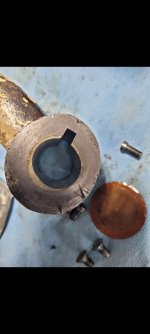
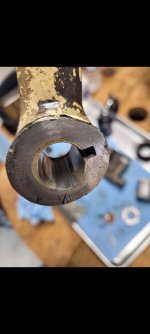

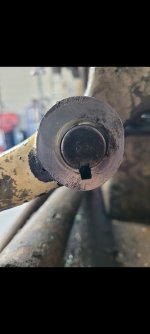

 . I'd still like to pour my old nuts to have a spare set and I have some bearings to do as well.
. I'd still like to pour my old nuts to have a spare set and I have some bearings to do as well.


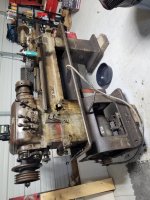
My Hendey has some wear in the same handle, though not as bad. pressing in a bushing is a good way to do it, however the trick is that you'll need to bore it out large enough that the new keyway doesn't cut the wall out of the new bushing, turning it into a 'C' shape, because then it won't want to stay pressed in the bore.
It looks like someone might have poured brass in the hole before (?). I've never done that but I suppose it would work as the C-shaped section would be bonded to the iron. Another repair option would be to fill the void with Babbitt when you do the half-nuts. You'll want to cook all the oil out of it so the Babbitt can bond to the metal and it would also help to grind or score some grooves into the walls to help lock the metal in place. It would likely be best to melt the brass out of it too. I wouldn't be surprised if it had a Babbitt liner when new from the factory as they did it on other things like bed-clamps that would drag along with the carriage.
With the nuts, there's lots of good information out there on pouring them. One thing to note is that the keyway cut along your lead-screw won't agree with a babbit pour, as you don't want that keyway reflected in the nuts, and you need to do them together so they line up perfectly. My old nuts had the Babbit stripped out of them and I was going to re-pour them until I lucked into a good used set. My plan was to cut a short dummy lead screw without the keyway to use in place of the actual lead screw. I got the thread mostly cut before my DIY ground Acme threading bit broke, and I just hadn't needed to finish it yet.
Babbitt Thread
(here's the thread I started awhile back).
I've got all the stuff to pour Babbitt, minus finishing the dummy screw, so if you'd like we can meet up sometime and have some fun with the oxy-acetylene. I'd still like to pour my old nuts to have a spare set and I have some bearings to do as well.
I sure appreciate the offer! I'll definitely take you up on it whenever the time comesAh, well no problem. The tools/materials to pour Babbitt are not hard or expensive to find IMO. You might double check if your leadscrew is the same 1 1/4" 6TPI Acme thread as mine, but if it is, let me know when you're ready and I'll loan you my dummy screw section.
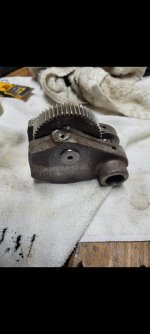
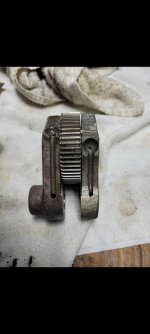

Mine is similar. Shaft is press fit in the gear. Why do you have to take it out?
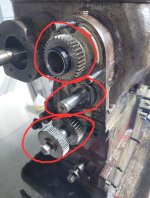
Looks like the "synchromesh" version of the lead screw reverseGot the bottom of the head stock done. Cleaned, painted, every moving part inspected, degreased, oiled, and put back together. I'm really happy with the results. View attachment 379294View attachment 379295View attachment 379296View attachment 379297View attachment 379298
I am guessing here, but the "old" Hendeys just had single tooth "dog" clutches that engaged with a minor thump if going slow and much more audible BANG if going too fastSo there are different versions for the lead screw reverse?
I take it the "Synchromesh" is referring to little engagement clutches as pictured below?
View attachment 379304
Very nice work!Looks like the "synchromesh" version of the lead screw reverse
So there are different versions for the lead screw reverse?
I take it the "Synchromesh" is referring to little engagement clutches as pictured below?
View attachment 379304
That's really interesting. I'll be needing some drawings sometime in the future for a few parts, ill give you a call once I get a complete list together of what I need.Sumo91:
What you have posted is he High Speed Reversing Mechanism. First introduced as an externally mounted attachment in 1910
and produced until 1915. Reintroduced in 1937 as an internally installed attachment and later as a standard item, available on
most Hendey lathes.
Hendeyman
Notice
This website or its third-party tools process personal data (e.g. browsing data or IP addresses) and use cookies or other identifiers, which are necessary for its functioning and required to achieve the purposes illustrated in the cookie policy. To learn more, please refer to the cookie policy. In case of sale of your personal information, you may opt out by sending us an email via our Contact Us page. To find out more about the categories of personal information collected and the purposes for which such information will be used, please refer to our privacy policy. You accept the use of cookies or other identifiers by closing or dismissing this notice, by scrolling this page, by clicking a link or button or by continuing to browse otherwise.
